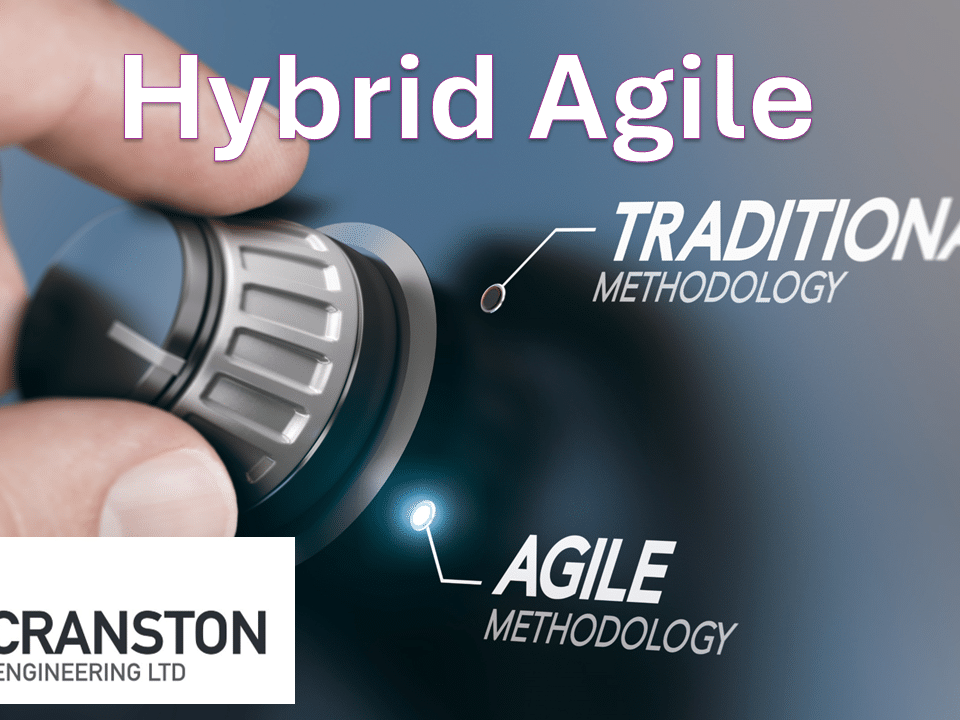The objective of this Blog is to explain the relatively new Project management techniques of Hybrid Agile and how they can potentially help you in managing your projects.
What is Hybrid Agile?
Hybrid agile is a blend of traditional Waterfall Project Management and Agile Project Management in the appropriate bespoke proportions for your projects.
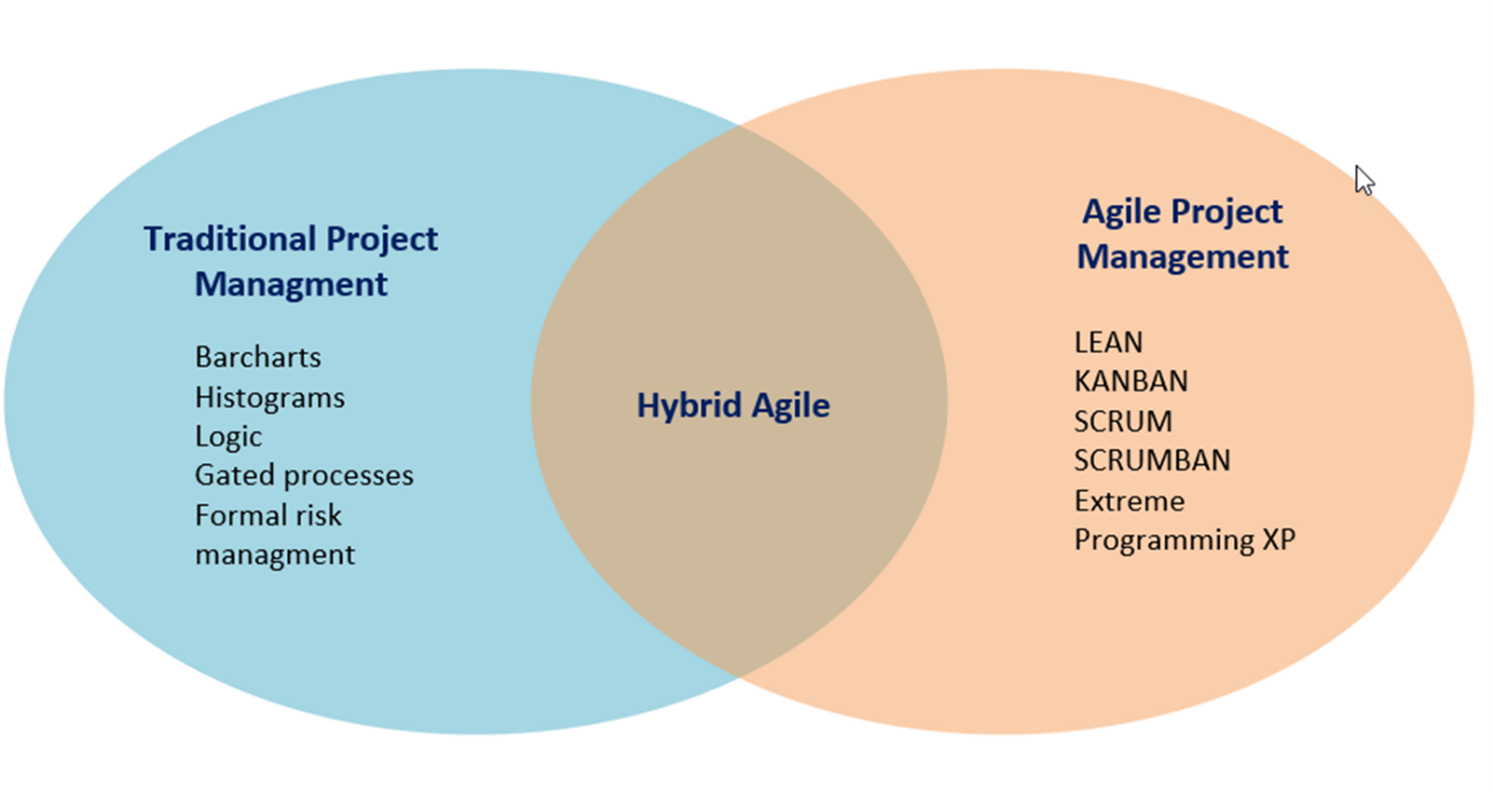
Traditional project management Follows the “waterfall” approach as shown above in the blue side of the diagram.
Agile Project Management comes from the “agile manifesto” developed circa 20 years ago by software experts. It now broadly means anything that adapts, evolves and provides incremental benefits as it proceeds.
These days the smart people use a bespoke blend of Agile and Waterfall methodologies to suit the project or process.
It may be heavily traditional, heavily agile or balanced between the two.
Lots of people and companies throw about the “agile working” words without knowing what it really means.
Why should I Go Hybrid Agile
You should consider going to hybrid agile where improvement in your process and delivery can deliver benefits. You need to do a business case to satisfy yourself and your management clients that there is value in the investment. Additionally, in a rapidly changing environment If you don’t implement you risk being left behind.
Typical Benefits Realized from Hybrid Agile
Please see the following lists of typical benefits realized by going the Hybrid Agile route.
- Best of both worlds
- Reduced process cycle times
- Reduced costs
- Better team spirit
- More satisfied clients
My Hybrid Agile Journey
My Hybrid agile journey started back in 2016 where the Project director gave me a bunch of KANBAN books one morning and requested that I implement for the project. I then Bought a white board and a whole lot of colored magnets.
The KANBAN Pilot Started with procurement and fabrication and then extended to engineering, subcontracts and close out. Over the following months we achieved good measurable successes.
Next was a program of smaller brownfield projects for existing UK North Sea offshore assets. Again, good measurable successes.
At that point stepped out to work as independent consultant and was invited to support a US Gulf of Mexico $14B project undergoing hook up and commissioning.
We are now currently providing remote support to a project team in Houston, and UK. This has resulted in the development of new tools /techniques and a Hybrid Agile course.
Business Processes supported.
The following list summarizes the business processes currently supported.
- Subcontracts
- Rentals
- Integrity Management (500+ scopes)
- Asset Maintenance
- QA Non-Conformances
- Plant Shutdowns
- Materials Disposition
- Contract Transition
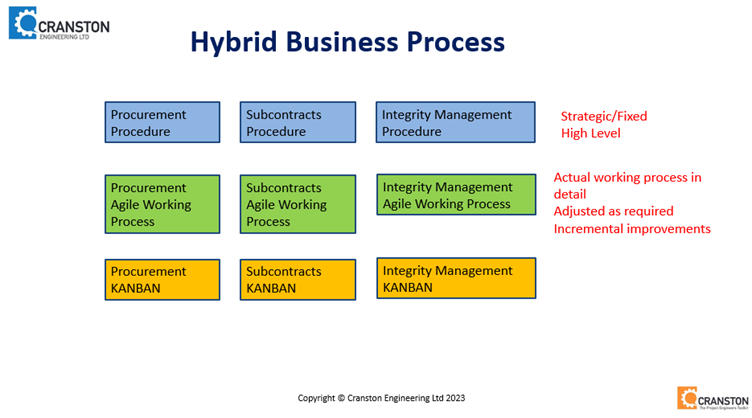
The above figure illustrates the Hybrid business approach.
At the top is the “Blue” strategic fixed high-level procedures for the program or project. These are purposely not too detailed to allow the implementation team flexibility in their working processes.
The “Green” working processes are the actual working processes, “warts and all” and are mapped and iteratively improved by the team whilst aligning with the “Blue” strategic processes. This gives the team flexibility to self-manage aspects of their processes.
At the bottom is “Yellow” the supporting KANBAN boards where the working process uses standard KANBAN techniques to manage the scopes.
Case Study: Integrity management
For our case study we will consider a program of circa 500 minor maintenance projects per year which were originally managed on a large excel spreadsheet.
The team experienced the following pain points resulting in stress and low efficiency.
- Multiple Non-Aligned Spreadsheets (COVID Hangover)
- No Visual Perspective
- E Mail inundation
- Missing/Lost Emails
- People developing individual approaches.
- Once weekly spreadsheet update
Post Implementation of a Hybrid Agile solution the team has realized the following benefits:
- Real Time data
- Visual communication (1000 times quicker)
- Everyone engaged.
- Less emails
- Team focused on same issue at same time.
- Team cohesion/team spirit
- Fewer meetings
- Estimated 2 hours saved per week per person (EMs)
- Hand off to reporting (Blue Cat)
- Hand off to Analytics (NAVE)
- Data driven insights to decision making.
- Continuous improvement retrospectives
We find that initial improvements can be seen in 2 to 6 weeks with significant improvements and Hybrid Agile process maturity within 4 to 6 months.
Next steps for a Mature Hybrid agile implementation
Continuous incremental improvement is the name of the game for Hybrid agile with the following now being implemented for the above case study.
- Data Analytics Approach
- Blue Cat/ Power BI Management dashboards
- Advanced Hybrid Agile Coaching
- Exploration of appropriate AI
Data Analytics
Clean data is vital to allow insights into the processes to be realized and to support decisions. By applying standard data cleansing techniques and coding data for easy analysis/manipulation a lot of value can be leveraged to assist in process pinch point identification and resolution.
Hybrid Agile Software Platforms
The main software system that we use is Trello, a cloud-based KANBAN system. This has been chosen as its feature rich and supported by a number of third party “Power ups” or Apps which increase the functionality. There are other software systems available which can be used in similar manner including Teams planner, Azure , Monday, Kanbanize etc.
One of the most powerful features of Trello is that it is a visual system with people estimated to assimilate visual information up to 1000 times faster than written text. This combined with sophisticated filtering and labelling capability allows mtg appropriate custom views to be shared with teams at the regular synchronization meetings .

Hybrid Agile Coaching
Hybrid agile implementations do not succeed based on a “teach and walk away” approach. It is important to continue to support and coach all team members to build their skills and to ensure consistency of approach.
Artificial Intelligence considerations
With the arrival of Artificial Intelligence, a Structured Hybrid Agile process using data analytics methods lends itself to the use of appropriate AI to find insights not easily visible and to support management decisions.
Hybrid Agile Process
The Hybrid agile process is summarized below.
- Position Statement
- Process mapping
- KANBAN Board
- Reporting
- Analytics
Position Statement
This is a structured approach to get all stakeholders to the same understanding and agreement on sequence of actions. Please see Position Statement
Process Mapping
The actual working process is mapped warts and all in order to get all parties to understand and agree on the whole process. This process is then used as a basis for continuous improvement.
KANBAN Board
A KANBAN board is then built based on the agreed working process and populates with the cards containing the individual work items.
Reporting
Reporting is provided at two levels.
A “ Power Up” called Blue Cat up is used to provide simple reporting. Configuration of this simple reporting can be taught in circa 1 hour.
More complex reporting is provided via hand of to Power BI which requires Power Bi skills.
Analytics
A further feature of Trello is An Analytics Power up with automates KANBAN analytics and provides insights in to process bottlenecks and issues which can then be used to prioritize work and process improvements
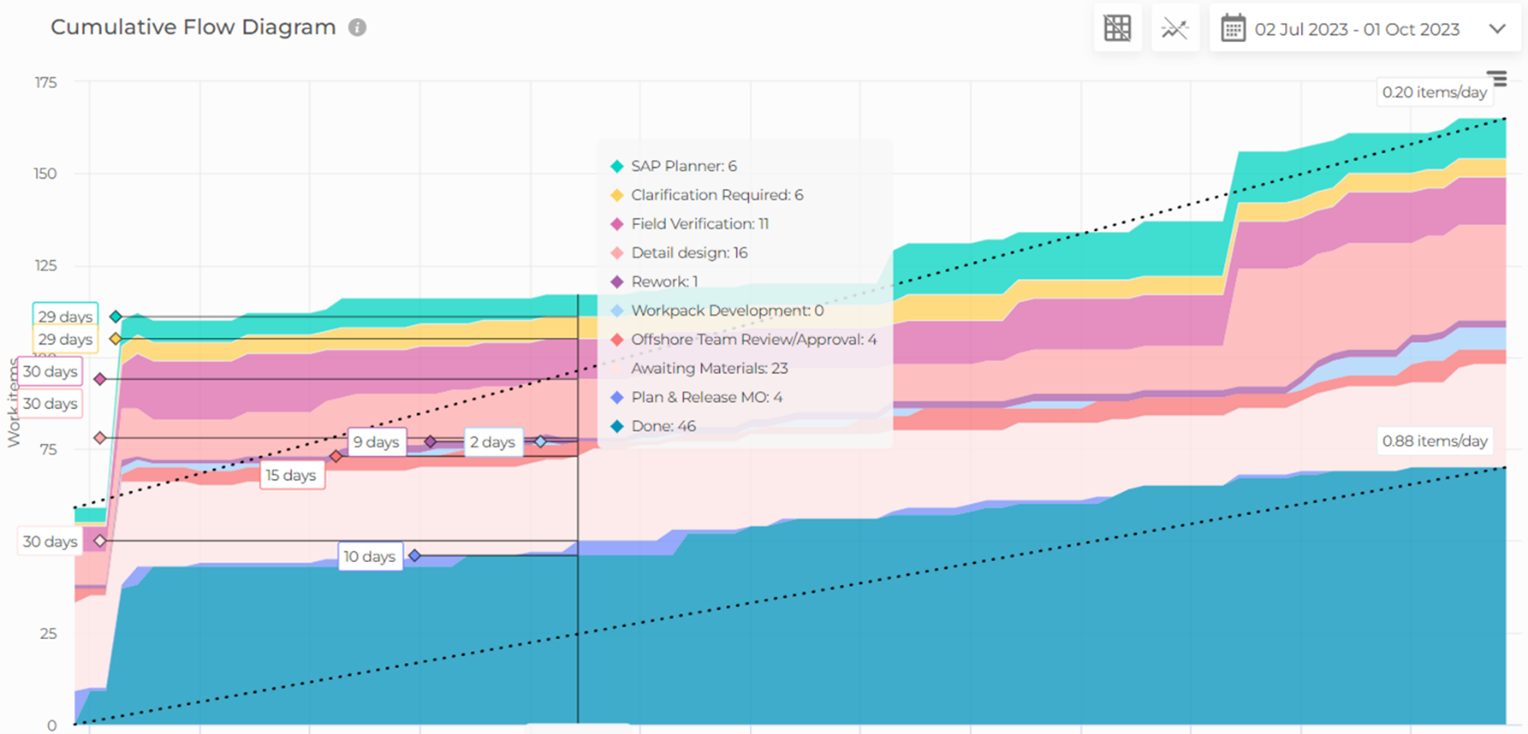
Cumulative Flow Diagram
The Cumulative Flow Diagram shows the amount of work in each process stage at a given time and can be used to identify emerging bottlenecks and to review process stability.
For more deatils on a sophisticated yet simple to use KANBAN Analytics software please go to Nave KANBAN Analytics
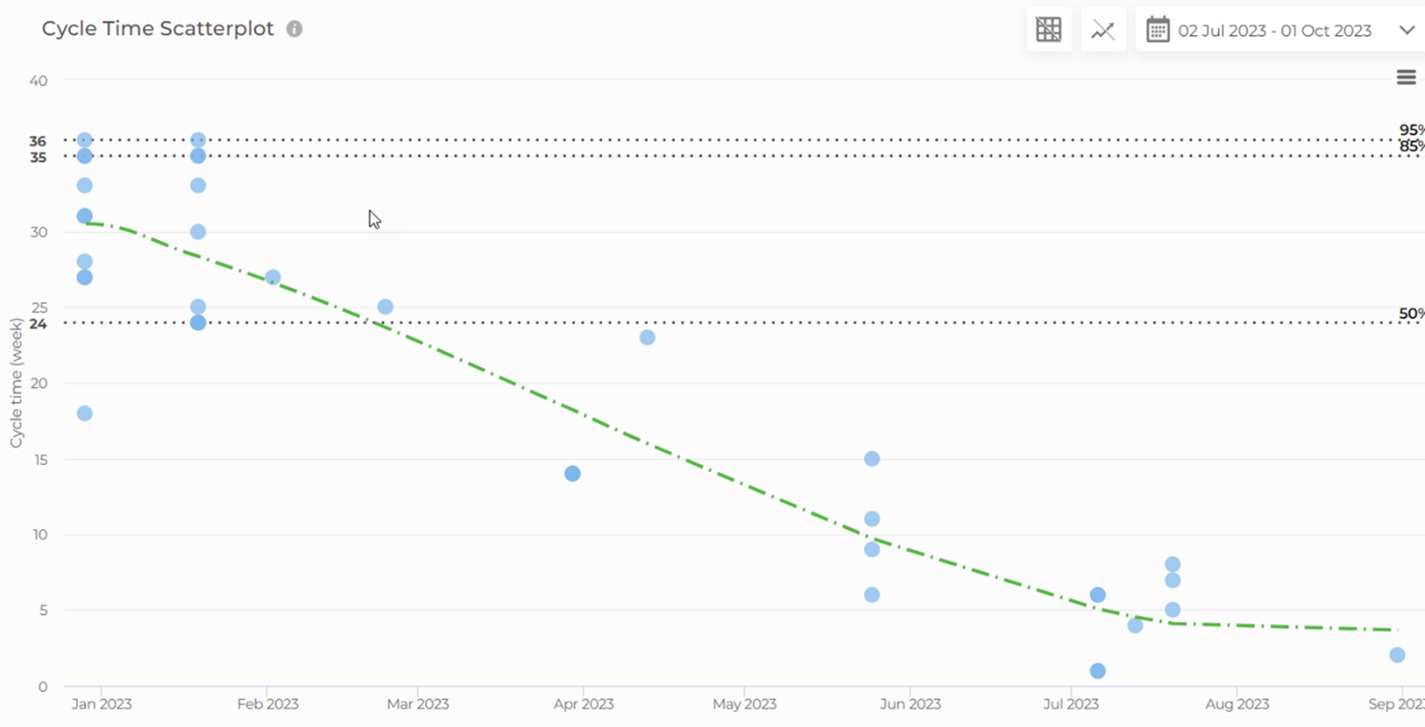
Cycle Time Scatter Plot
The cycle time scatter plot captures the cycle time for each scope in the selected parts of the process and more importantly a trend line on how cycle time is increasing or reducing.
Hybrid Agile Success factors
For hybrid agile to work there are several “Success factors to be considered.
- Project Management Training and experience
- Awareness of change impact on people
- Well developed “soft skills”
- Attendance at a Hybrid Agile “Super users” course
- A continuous improvement mindset
- Enthusiasm
What Does the future Look Like for Hybrid Agile
- From Teams to Enterprises
- From individual process to Value Streams
- From Project to Product Management
- Team Leadership to Executive Leadership
- Cross Fertilization between Industries/Geographies
We see Hybrid agile spreading from individual teams and projects to complete enterprises as experience is gained and the culture and mindsets are adopted.
We also see clients starting to complete value stream mapping across their processes when aligning with Hybrid agile. The KANBAN process also allows the enterprise to model its entire business of completing projects as a process.
To work the executive teams, need to fully engage with hybrid agile concepts and to get their “hands dirty” in order to fully understand the tools. And finally different locations from the same enterprise can share learnings and best practices vis appropriate forums.
Conclusion and next steps.
Hybrid agile delivers measurable project and program business improvements with result in lower costs, reduced duration , less team stress and more satisfied clients
If you are interested in finding out how Hybrid Agile can help your organization, please contact us for a no commitments initial discussion.

